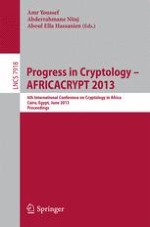2013 | Buch
Progress in Cryptology – AFRICACRYPT 2013
6th International Conference on Cryptology in Africa, Cairo, Egypt, June 22-24, 2013. Proceedings
herausgegeben von: Amr Youssef, Abderrahmane Nitaj, Aboul Ella Hassanien
Verlag: Springer Berlin Heidelberg
Buchreihe : Lecture Notes in Computer Science
